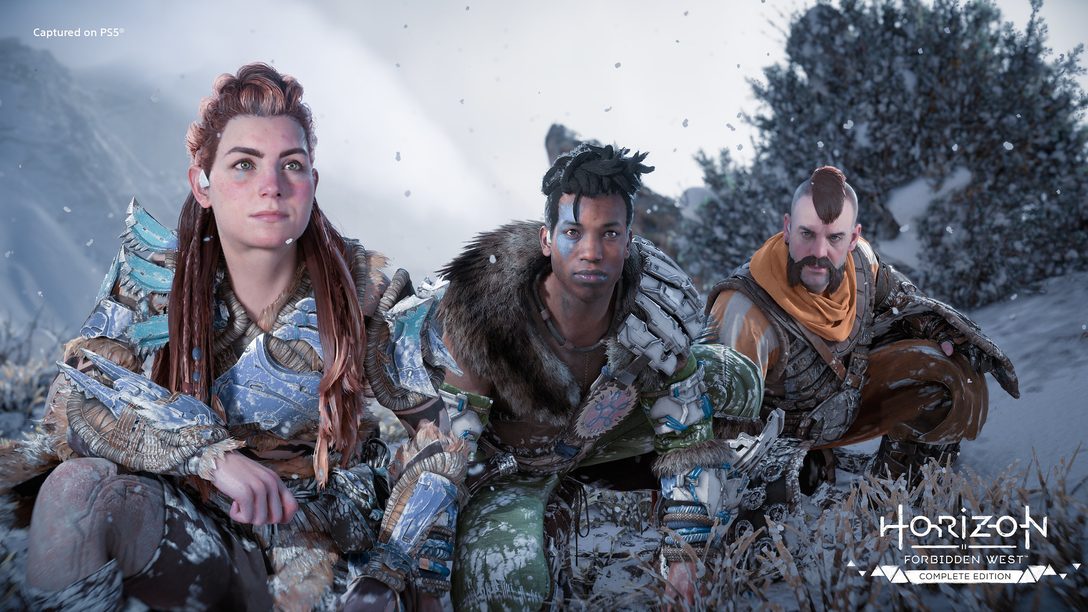
Guerrilla developers go in-depth on the games’ character building from conception to creation.
The world of Horizon Forbidden West brims with life across its spectacular landscapes, fierce roaming machines, and thriving cultures that populate a renewed land once ravaged by the biomass-consuming machines of the Faro Plague.
And though the wilds are breathtaking, and the machines are massive, Horizon’s third essential element is its authentic tribal inhabitants. On her mission, Aloy meets a varied and colorful array of compelling characters, each with their own hopes, journeys, and motivations.
Weaving real personalities and genuine humanity into these characters was a feat accomplished together by many teams at Guerrilla. This PlayStation Blog explores those processes, from the narrative foundations of character development to capturing the perfect performance and ultimately implementing them through cinematics and conversation design.
Each stage is crucial to ensure the characters of Horizon are as realistic and full of depth as the world around them.
Spoiler Alert: Please note this article may contain some spoilers for Horizon Forbidden West, Horizon Forbidden West: Burning Shores, and their storylines.
Building compelling characters
When players meet a character in Forbidden West, their place in the world of Horizon is entrenched and clear: we quickly understand their personality, desires, and fears. We may learn they hold certain beliefs due to their upbringing, why they may be rebelling against the status quo, and ultimately, we see how their task crosses over with Aloy’s.
For the narrative team, each character starts with a fundamental question: what does this person want?
“We always start with conflict,” says Annie Kitain, lead writer. “Once we have a pretty good idea about this, we are able to figure out the rest of their character and how we can experience this conflict in the story.”
By starting with a character’s desires and identifying obstacles in their path, the writers establish direction for penning dialogue and seeding subtext—not solely what the character says, but also what they left unsaid and what that may truly mean.
When examining motivation, the narrative team assesses the circumstances that would determine a person’s personality. One example is considering a character’s relationship with others or their surroundings. This approach makes for developing cohesive worldviews and believable interactions, ultimately informing each character’s treatment of Aloy.
“For the writing team, a fun task was accounting for a character’s evolving attitude towards Aloy throughout the main story. A character could have two (or more) different sets of dialogue depending on how well-known Aloy is due to her actions.
“We see characters as a reflection of their tribe’s beliefs, customs, and conflicts, and to better understand them, we need to spend more time with them. You’ll notice that characters will come with Aloy on a quest more often than before. This allows us to get to know them better than if they were only present in cutscenes.”
The growth and development of Aloy’s companions were also closely tied to and paced alongside the huntress’ own conflict in the main story. Each of Horizon’s tribes has distinctive beliefs and disputes, but the imminent threat at the center of Forbidden West affects them all, albeit in unique ways.
“Many characters’ understandings of the world grows so much over the course of the game – something that, previously, Aloy was practically alone in knowing.”
The narrative team collaborated closely with other disciplines to ensure story beats paired with character development so this parallel growth felt organic and natural.
“We work closely with design, cinematics, art, and audio to make sure these emotional beats land and the pacing works,” says Annie. “It’s a very iterative and collaborative process that continues throughout development, with a lot of feedback and adjusting. We all want to get it right so that, in the end, the story lands with players.”
Once the narrative team sets the groundwork, other teams at Guerrilla bring the vision—and the characters themselves—to life. Jochen Willemsen, associate cinematic director, notes that this all starts with casting.
“Casting is crucial. We have a very specific process we follow on how to cast important roles,” Jochen says. “For the parts, I always spend a lot of time figuring out what the narrative team is after and how to find talent that can get that across or even add to it in a way the writer may not have imagined.
“Once you’ve found the right actor, you focus on truly understanding the scene, the subtext, and what the outcome of the scene should be: what function does the scene have for the story and/or the gameplay.”
Working with actors in video games presents a unique challenge. Jochen emphasizes that, unlike some TV and film performances, actors cannot rely on elements like costumes or sets to get into the character; it’s more similar to a green screen set.
“In a way, as a director, you must work a bit harder to give them context and get their imagination going. You have to be vigilant to ensure the talent understands why their character says certain things. Keeping the actor engaged with the material is crucial and constant hard work.”
As a director, Jochen remained focused on capturing the performances the scene needed. Even one of his favorite scenes to work on—Aloy and Morlund crashing in Morlund’s hot air balloon—was a challenge. Due to the stage of the project, the voice-overs needed to be recorded separately, but his understanding of the vision for the scene allowed him to help the actors click, even though they couldn’t be in one another’s presence.
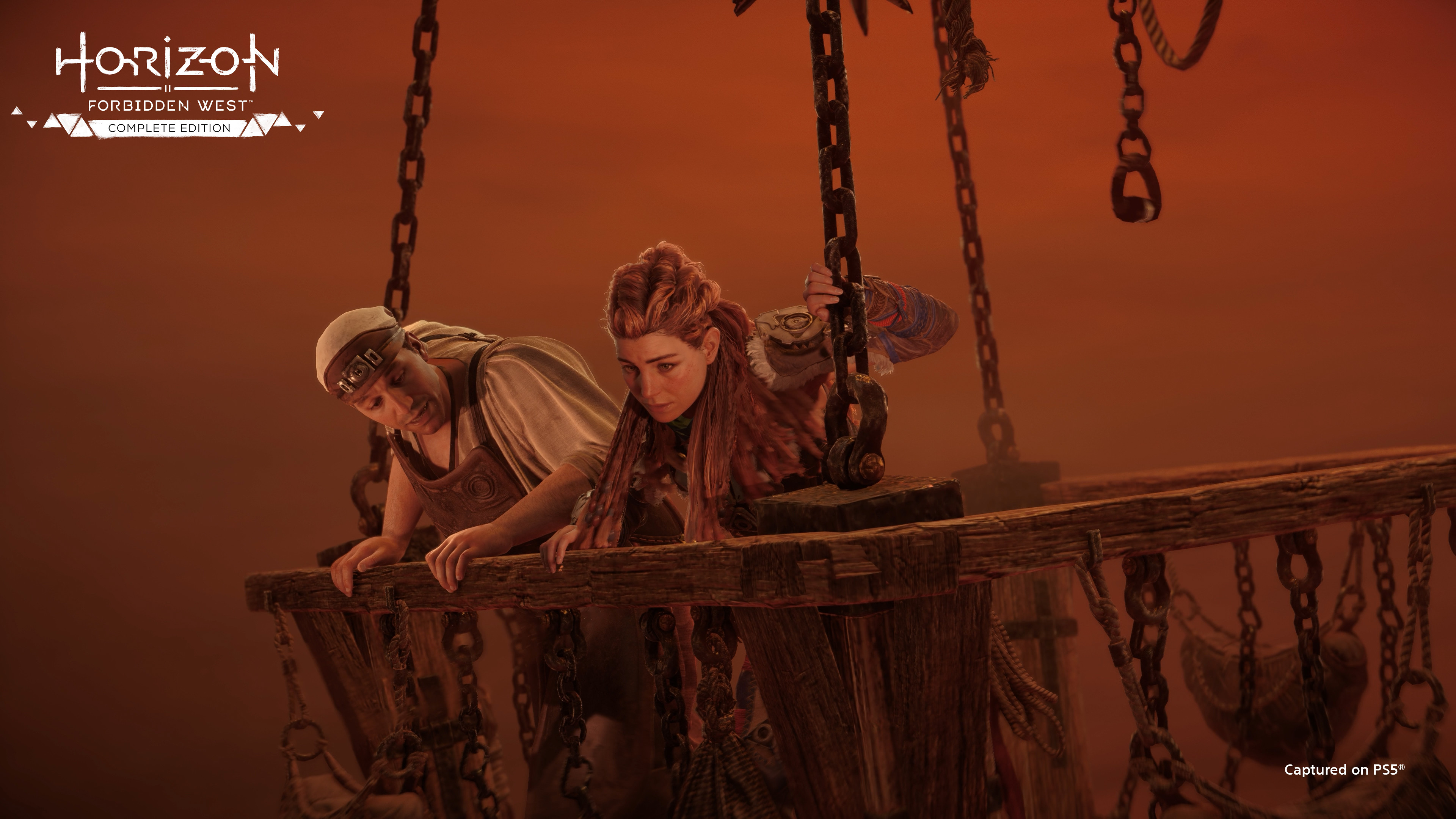
Beyond capturing performance, Jochen simultaneously considers how the cinematics team will work with the material, keeping camera angles and techniques in mind when working with actors.
“Assembling a sequence requires lots of individuals from different departments to realize what the narrative team has put on paper,” explains Alexander Hush, senior cinematic animator. “The actors’ captured performances are translated to the digital versions of the characters and assembled together to create cinematic moments and relationships between Aloy and the characters she encounters.”
The collaboration in this process is crucial. A key aspect of capturing the right emotional tone in cinematics came from the actor’s performance, and it was up to the cinematics team to ensure that the compositions and lenses they used complemented the emotional state of performances.
“Authenticity is an important factor that [Ismaël Auray, former cinematics director] looked for, and he worked closely with the actors to get natural performances in which each character has a life and story,” adds Ari Teger, senior animator on the team. “How they interact with Aloy during her journey can create unexpected and interesting character moments that make a scene much more interesting.”
Crafting memorable moments
The cinematics team at Guerrilla is responsible for conveying the story beats of Horizon Forbidden West through non-interactive cutscenes. Going into the project, they wanted to elevate the quality of the scenes far beyond those of Horizon Zero Dawn. Motion capture technology had improved significantly since 2017, so the team focused on cinematic camera work. They implemented subtle pans and intentional movement, achieving the more grounded, real-world feel of Forbidden West.
Michel Lefèvre, senior cinematic animator, explains that this all starts in the layout phase. “We initially assemble the base elements of what makes a cinematic scene: the motion capture data, the dialogue audio, and the environment geometry. We try variations of the scene to find the best possible version. It must communicate the story in the clearest way possible – that way, the player can get back to the action without lingering, and the immersion is preserved.”
Similar to the narrative team’s approach, they looked at how a scene between characters fit into the context of Aloy’s story, with their techniques dictated by this goal.
“Our director had determined a set of prime camera lenses that we used throughout production,” says Ari. “This includes wider shots when we need to see more of the environment, such as when Aloy is entering a new area for the first time. Longer lenses are used when we need more intimate closeups of characters and when we are focusing on more emotional moments.”
Ari notes that this was one of the team’s core principles: that everything should be portrayed from Aloy’s perspective. This approach ensures the player’s connection to the events and characters surrounding Aloy’s journey, ultimately conveying the intended emotional tones and deep connections between the protagonist and those she meets.
“All the needed information is coming from the performance,” adds Michel. “A wide shot would be used to show conflict between two characters, showing the space that separates them. The camera can stay longer on a character after a line to communicate their thought process or show the listener instead of the speaker to reveal an important reaction.
“And to convey a character’s feelings and show them as human and believable, we would prioritize facial animation—eye darts to convey a thought process, blinks to show doubt. The goal of the layout phase is to find the key moments of the performance and show them at the right time to convey the story beats in the best possible way.”
Michel compares their approach in Horizon Forbidden West to classic Hollywood movies, where the camera movement is driven by the actor’s motions. This movement doesn’t attract attention but naturally complements the blocking and serves the actor’s performance. He particularly enjoys the scene when Aloy first meets the Oseram delvers in Vegas. Right away, the player understands that Aloy and Morlund are off to a great start – not just because their missions align but also because the camera emphasizes their interaction and collusion.
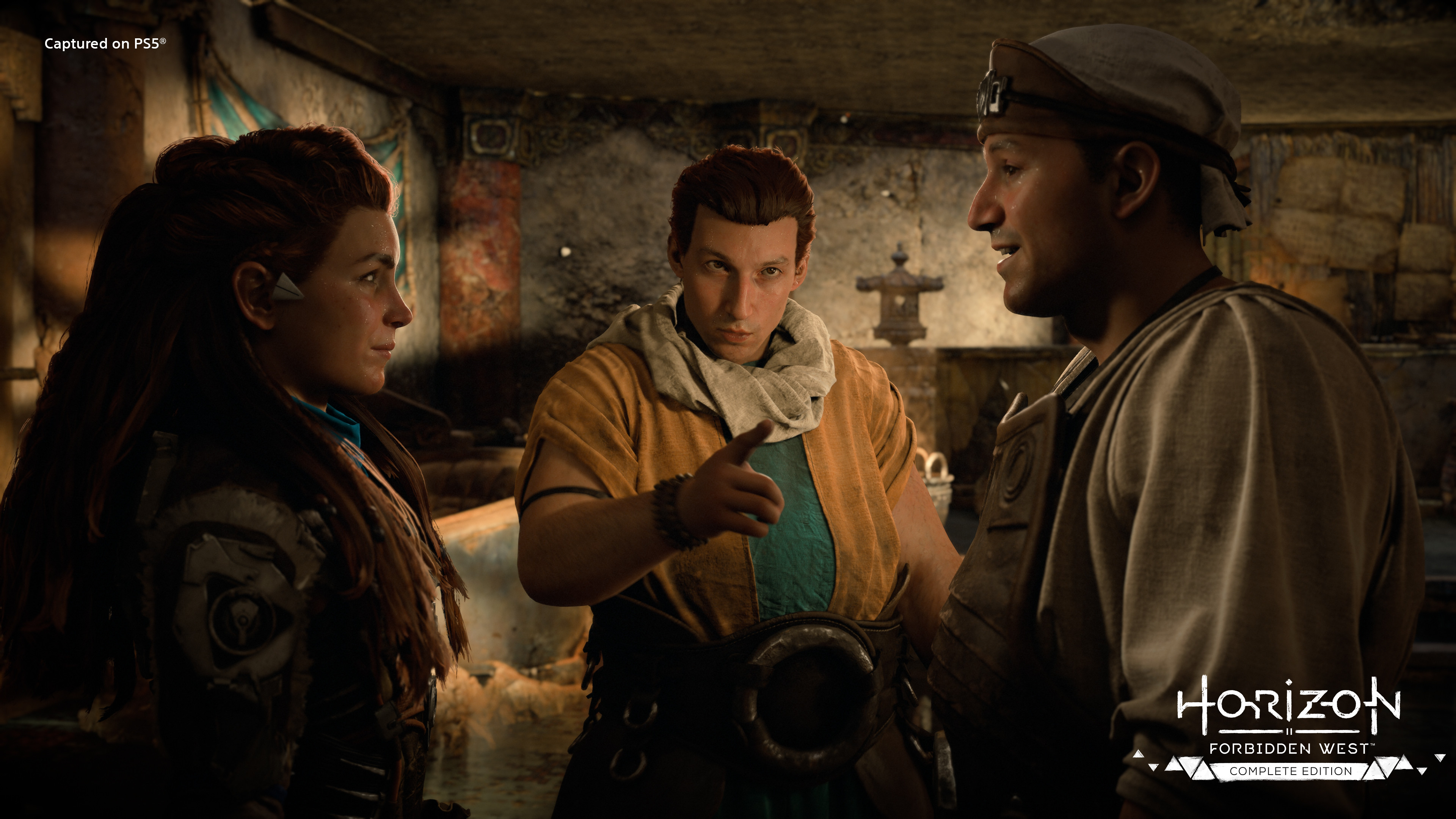
“In that scene, Aloy and Morlund start to connect. The camera is close to them as they look at each other. In the background between them stands Ababund, who doesn’t like Aloy and Morlund getting friendly so quickly. He interrupts them and drags Morlund away from Aloy.”
When capturing emotion in a scene, Ari calls out a scene he loves from Horizon Forbidden West’s DLC, Burning Shores. Set against a beach, Aloy attempts to console her companion, Seyka, after a shocking revelation has shaken Seyka to her core. This moment leads up to Aloy realizing she has feelings for Seyka.
“It’s always a fun challenge to construct a scene in various ways to see what affects the emotional tone of a scene. Letting a moment breathe can really drive an emotional beat home,” says Ari. “We really wanted to build Aloy and Seyka’s relationship over the course of the story. We wanted to play up that moment, building up to closeups as they shared a tender moment. The animation team did a great job adding an extra level of polish and detail to these scenes, where we really get a sense of what Aloy and Seyka are thinking at that moment.”
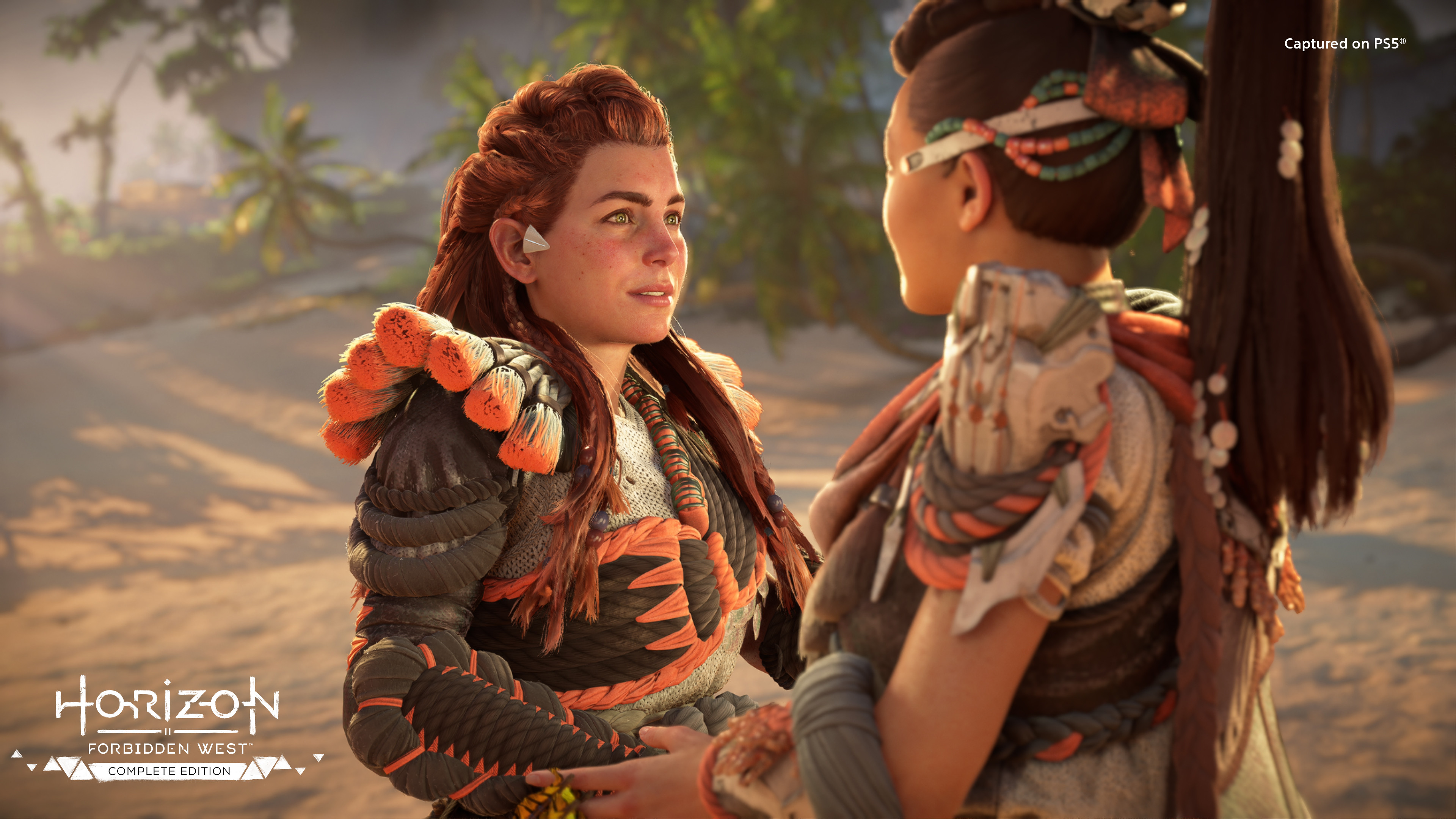
“I think the slower moments shine in our cinematics, whether when Aloy meets the charismatic Oseram craftsmen in Vegas or a more heartfelt moment between Aloy and Seyka,” he adds. “It was great working with the narrative team through these moments, really seeing the characters come to life.”
Conversations about conversations
The cinematics team had set a high bar for realism. That same eye for detail now needed to be cast over the equally essential interactions, and so Guerrilla assembled the conversations design team to elevate their quality.
Compared to a cinematic, Guerrilla defines a conversation as a dialogue-centric scene—all the interactive moments where Aloy talks with non-playable characters (NPCs). The goal was to elevate conversations to a quality level comparable to full cinematics. That way, the difference between a conversation and a cinematic would be minimal, improving player immersion.
Marion Allard, senior conversations designer, describes this practice as being similar to movie-making. “For Horizon Forbidden West, the goal was to bridge the gap between mocapped, custom-made cinematics and character conversations–and push the envelope by capturing bespoke mo-cap data for the entirety of the content.”
“A conversation typically takes place in a limited space in a single location,” explains PJ Hughes, cinematics sequence lead. “So we work with the conversation system as a base, and then build on top of that, which then works similarly to working on cinematics.”
Horizon Zero Dawn relied on a procedural generator that built conversations from a script automatically. PJ would then polish these scenes manually as the sole designer of conversations at the time.
“For The Frozen Wilds DLC, we experimented with adding motion capture to raise the quality closer to that of our cinematics,” he says. “Players responded well to the greater expression of the characters, which really enhanced the great voice performances. So for Forbidden West, we wanted to go a level further.”
“We still used this automated system as a convenient basis to quickly have a basic version of every conversation in the game before adding properly timed-out voice lines, bespoke mocap, facial expressions, and custom cameras to every single one,” adds Marion. “Broadly speaking, you can say we switched from a procedurally generated approach to an entirely handcrafted approach to reach much higher levels of immersion and quality.”
The great results the conversations design team came down to the level of detail they considered with each scene and character. “First, we have plenty of character-specific considerations: what is their emotional state when Aloy meets them? Is there distress or urgency frequent for quest-givers? Do they have hidden motives? Do they know who Aloy is-–are they impressed or wary?
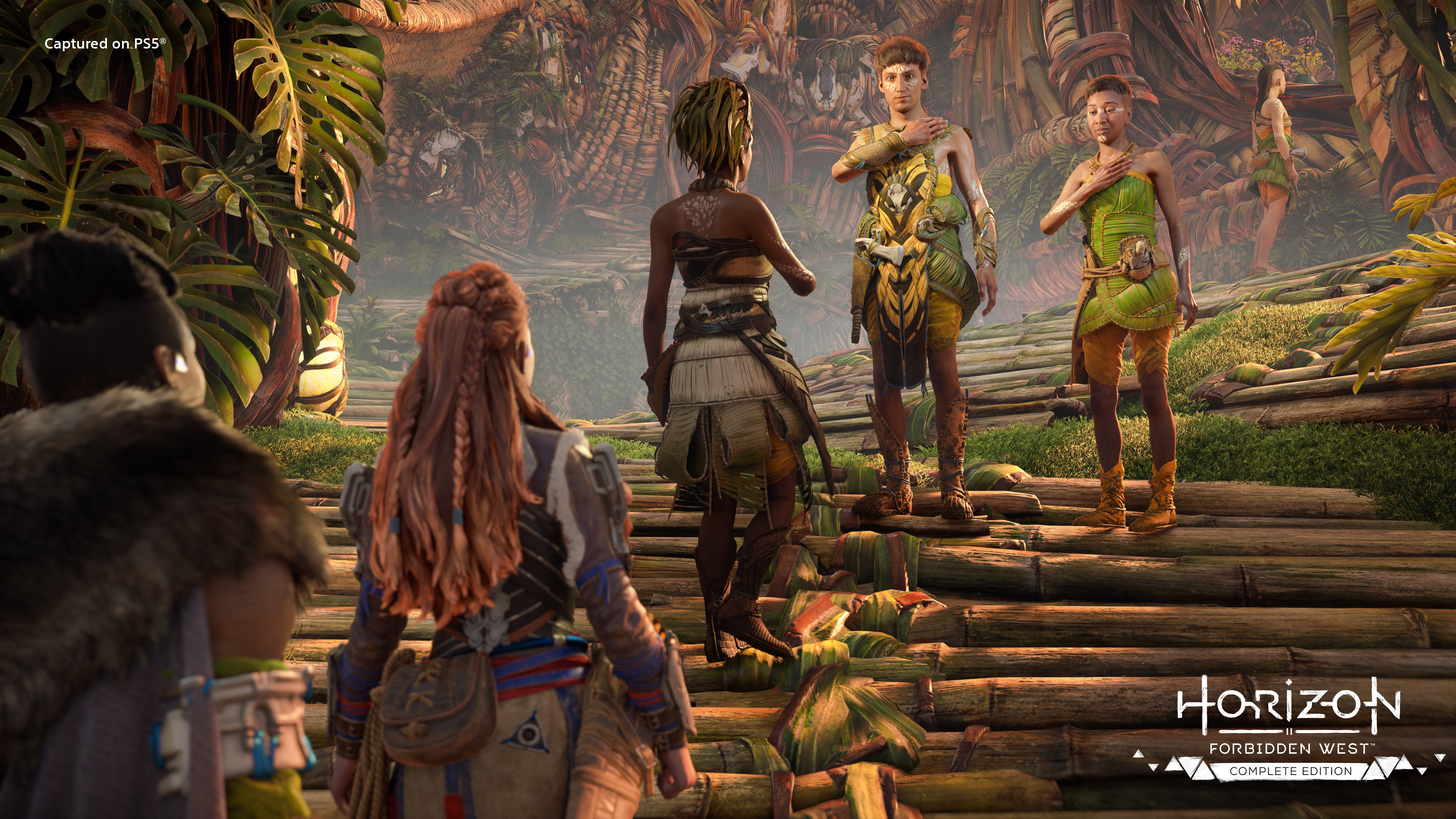
“The various tribes are a central part of Horizon’s world-building. We made sure each tribe had its own culturally specific gestures and mannerisms. For example, the Utaru characters touch the seed pouch on their chest when showing emotional vulnerability.”
These small details added to building the authenticity of the conversation and, by extension, the characters themselves. By seeking a complete understanding of a character in their design, they established each character as an active, sensical part of their world rather than simply a quest-dispenser for Aloy.
“We discuss the intentions further with the narrative team and make suggestions for adjustments. For example, the script mentions a prop. Do we need this to be bespoke? Or would an existing asset serve the purpose?” PJ explains. “We discuss the location with environment art to find a good place for it to help tell the story. We work with the quest team on the technical details. What state does the scene start and end in? What direction do we want to leave the player looking in?”
An excellent example of this approach was Aloy’s conversation with Gildun, an Oseram delver that players first met during The Frozen Wilds. Gildun returns in Burning Shores, reuniting with Aloy after being trapped during an expedition. The two search for his missing delving partner, Olvar, while they joyfully work together to overcome the area’s puzzles.
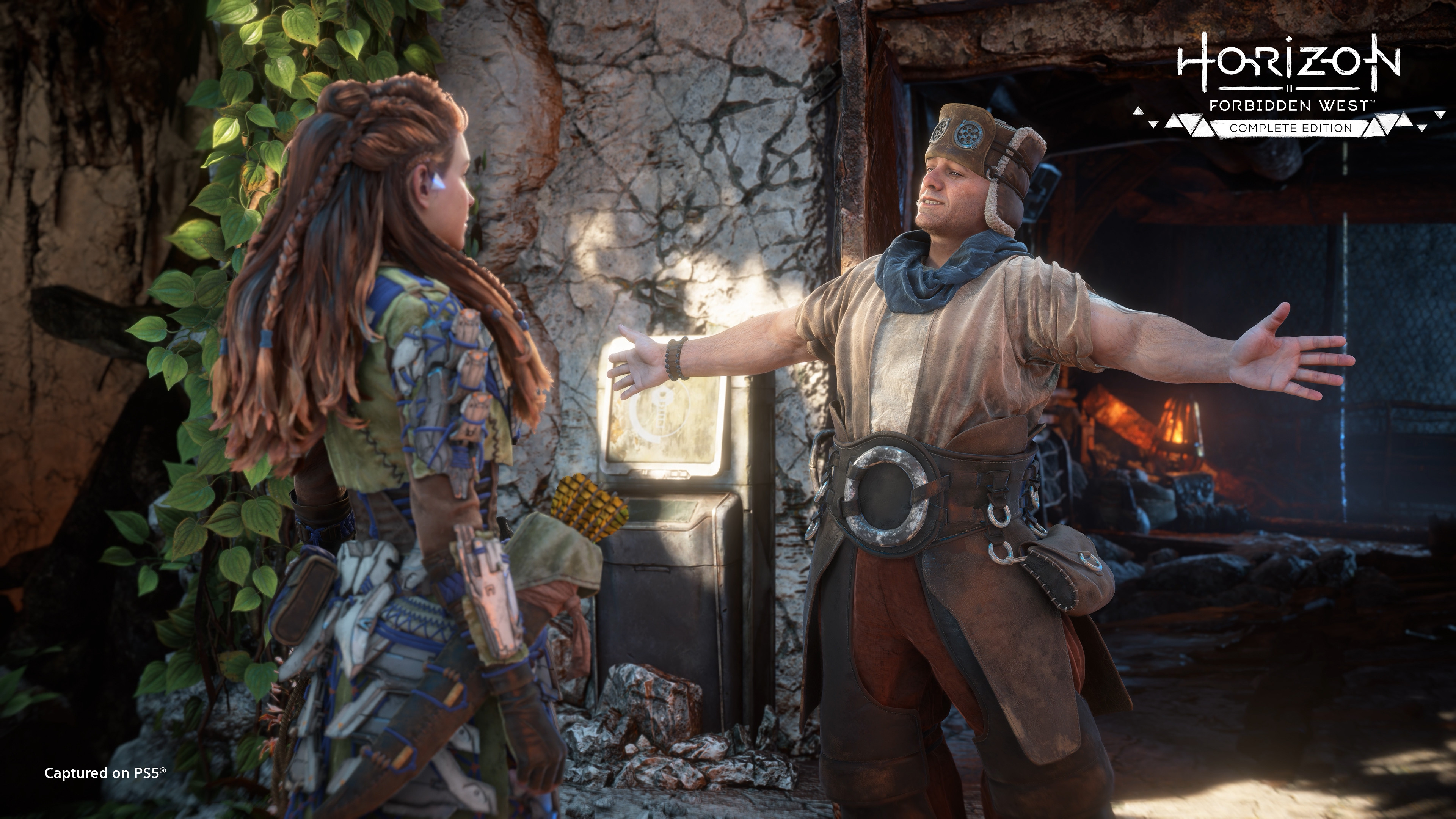
“We look for opportunities to make the conversations more dynamic. We avoid static talking heads,” PJ adds. “Gildun is great fun to work on. He is so boisterous and in his own world. The thing that I think makes him great are those emotional moments where you see the bravado. Getting those moments right makes for an interesting, endearing, rounded, believable character.”
The end result
The goal of bringing the characters of Horizon Forbidden West to life was a shared one. With several disciplines in game development working in parallel, the teams needed to stay focused on how the player would experience the world of Horizon through the characters they meet.
“We need to balance flexibility and immersion,” says Marion. “Horizon Forbidden West is an open world: players might do things in any possible order, and to remain immersive, the world and characters should account for that.”
In the end, many teams at Guerrilla brought together their technical expertise to realize their vision: a world where everything the player engages with—the wilds, the machines, the settlements, and finally, the people—feels full of life.
“We like to view getting to know the characters that Aloy meets as an opportunity to gain insight into their world,” says Annie. “So whether players love a character or love to hate them, we hope they enjoy getting a deeper understanding of the world of Horizon and the hopeful, funny, flawed, and complicated people who inhabit it.”
—
Horizon Forbidden West Complete Edition arrives on PlayStation 5 on October 6 and PC in early 2024. You can wishlist this for PC now:



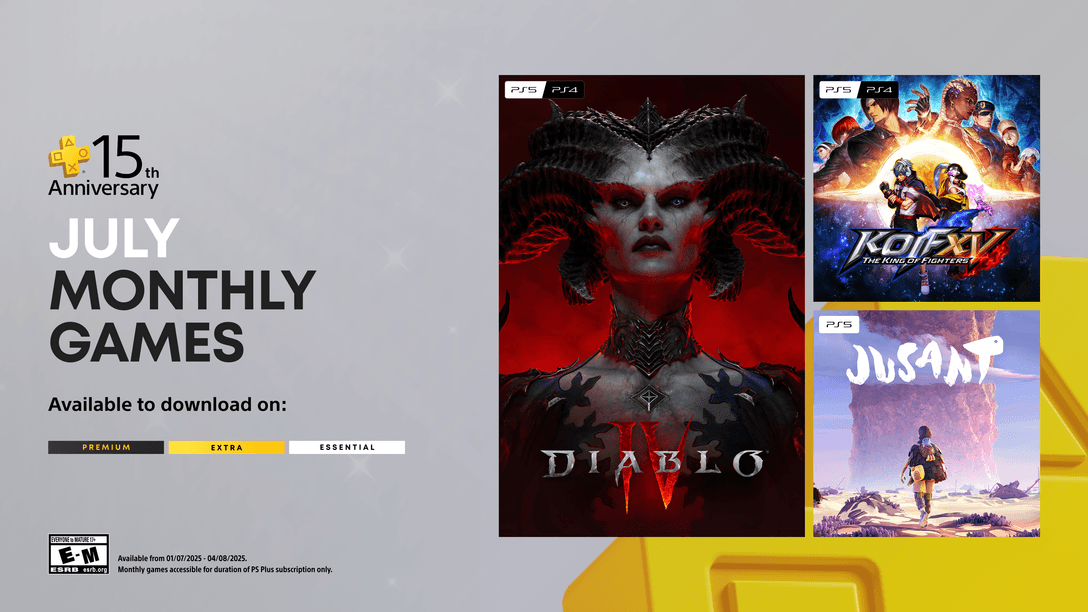

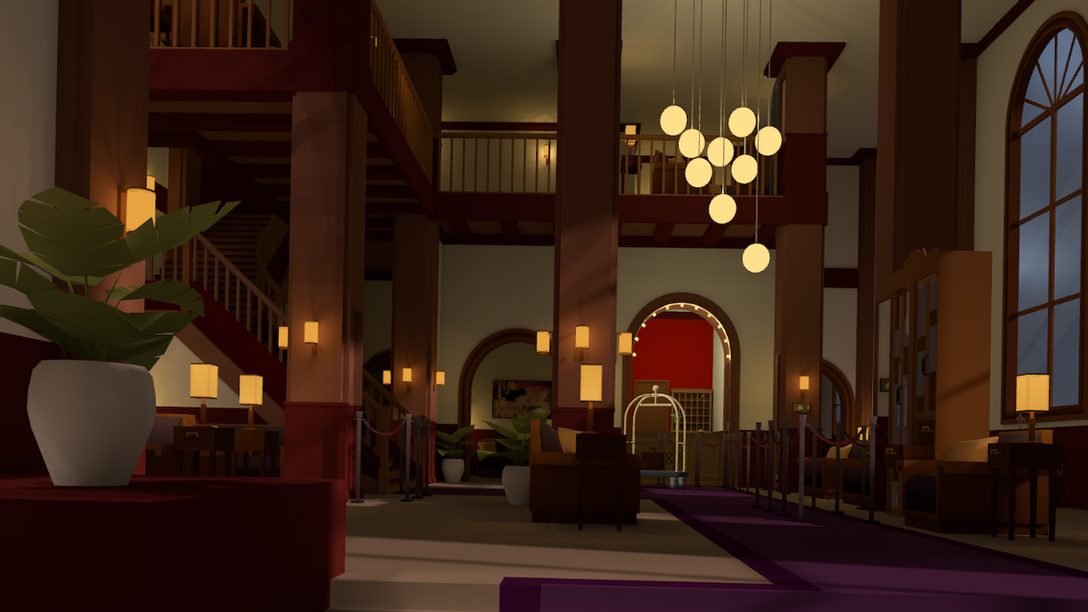





Comments are closed.
39 Comments
Loading More Comments